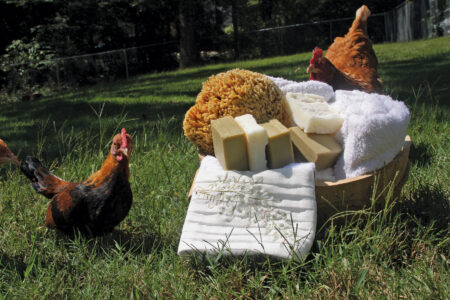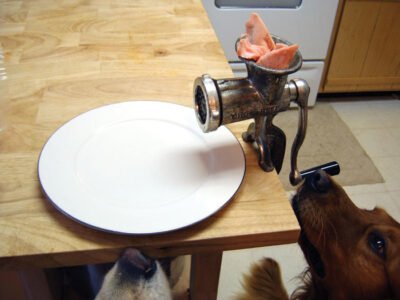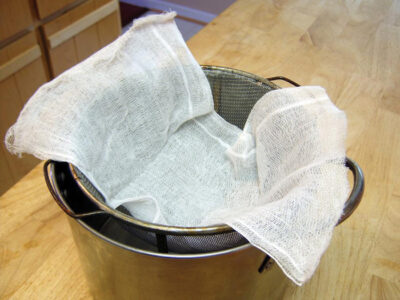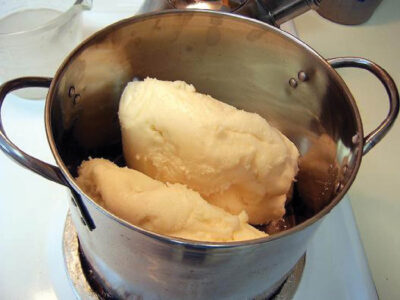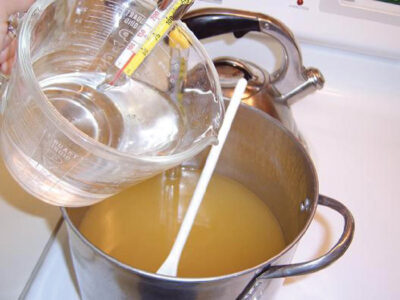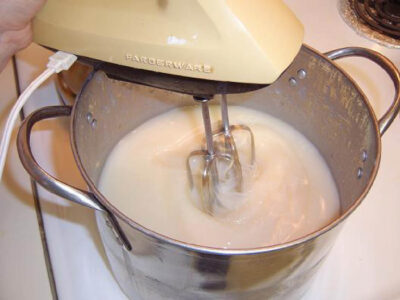Learn how to make soap inexpensively using ingredients others might have thrown away. These easy handmade soap recipes can be used on your body and clothes.
Soap is essential to our existence and enjoys a rich history of prolonging human life (and enabling us to tolerate close quarters with one another). As with any process that dates back a few millennia, there is quite a bit of legend and myth surrounding both the origin and manufacturing of soap. But once you cut through all the grime, you see that making your own soap is easy, inexpensive and cleanly rewarding.
Easy Homemade Soap Recipes
In one of the best-known legends, soap takes its name from Mount Sapo, a place where the ancient Romans performed many animal sacrifices. Rain then washed the mixture of animal fats and wood ash onto the clay banks of the Tiber River, where women scrubbed their families’ clothing and first discovered that the soapy water made the clothes much cleaner. Although animal sacrifices would probably not have created enough fat to make soap, it is from this legend that the name for the process of making soap, saponification, comes (see “How Lye Becomes Soap“).
Most experts credit the ancient Babylonians with first producing soap, since they carved a tablet with the first-known soap recipe in 2800 B.C. The Babylonians, Egyptians and Mayans were bathing regularly in sudsy bubble baths, while other early (and stinky) peoples were still whacking each other over the head with wooden clubs in caveman fashion.

Early soap makers boiled animal fats, water and lye (made from wood ash) in large kettles. They tested the strength of their lye solution by floating an egg in it. In 1790 LeBlanc, a French chemist, figured out how to create sodium hydroxide (lye) from sodium chloride (table salt). Soapmaking practices changed dramatically, and using soap no longer involved risking your hide.
So, how do you make soap properly and why bother doing so in today’s world, where it’s so readily available? Isn’t making your own soap expensive? Isn’t lye dangerous?
Truthfully, making soap can be as expensive and complicated as you decide to make it. If you want to keep it inexpensive and simple, lard and beef tallow are your friends. Once you have mastered traditional soap, you may want to dabble in soaps that include pricey oils, butters and scents.
Beef Tallow Soap Recipe
This economical, soft bar soap is not your grandma’s lye soap, but it’s pretty close.
The first step is to befriend your local butcher and ask her to save the fat trimmings from the various cuts of beef she processes. Since those scraps are often discarded, you can obtain the tallow for free if you’re willing to render the tallow yourself.
- Gather a large pot, colander and cheese cloth. Set them up with the cheese cloth lining the colander so you can eventually drain the melted fat into the pot. Now grind up the fat with a cast-iron meat grinder or food processor. If you use an old-fashioned meat grinder, be prepared to take it apart a few times because it will clog with sinew.
![]()
- Place the ground trimmings in a kettle with 1 tablespoon salt per pound of trimmings and cover with water (the salt ensures that when you make soap, it makes firm bars; otherwise you end up with mushy soap). Let this mixture slow cook on low heat until all that remains is a gray bubbling brew with bits of gray hamburger floating on top. Be sure you keep the exhaust fan on. You might also consider completing this process outdoors.
- Pour the contents of the kettle into the cheese-cloth-lined colander, and let it strain out. If you still have trimmings to process, repeat the steps above. Collect the liquid that drips through the filter and refrigerate overnight.
![]()
- The next morning, collect the solidified white fat (tallow) from the top of the container and discard the brown jelly. Weigh this rendered fat and use a fat calculator (such as TheSage) to figure out how much lye and water you will need to make a batch of soap. Need conversions? Visit All Conversions.
![]()
- Gather lye, distilled water (or rain water), scales, a stainless steel kettle, resin cake pans or soap molds, a glass measuring cup with a handle, two candy thermometers with kettle clips, and the tallow. Goggles and gloves should be handy, too. Lye (sodium hydroxide) can be found in your local hardware store in the plumbing section. I don’t advise making it from wood ash, actually. It can be done, but the results vary.
![]()
- Measure out the lye and water. Now, pay attention. Make sure that you are either outdoors or the exhaust fan above your stove is on. Add the lye to the water. The water will get extremely hot. Watch the thermometer to see the temperature climb. It’s amazing!
- Place the tallow in the kettle and begin to melt it on low heat. Stir frequently with the fan on. Attach thermometers to the lye water measuring cup and the kettle full of tallow.
- Once the lye water and the fat reach roughly the same temperature – about 100 to 120 degrees Fahrenheit – add the lye water to the fat.
- Stir. Now keep stirring. I like to use a hand mixer (a yard sale find), but stick blenders are nice, too. I stir for a while, take a break, and then come back to stir some more. Some people will tell you that you must stir constantly and never leave the mixture alone. But I’m not some people. Stir at least every 5 to 10 minutes until the temperature rises 2 or 3 degrees Fahrenheit.
![]()
- Once the temperature has risen a few degrees, pour the mixture into molds. I use resin cake pans because I don’t have to line them and the soap is easy to remove after hardening.
In 24 hours, remove the soap from the pan(s) and cut into bars. Let the bars air on cooling racks or use produce containers. Some people will tell you that you must age the soap. You don’t actually have to age the bars. They really are perfectly safe to use if you have followed the advice of the lye calculator.

How much did it cost? I purchased the lye for $1 a can (on sale) and used about 1/4 of the can this time, got the rainwater from the sky, and obtained the four pounds (in this case) of fat for free. I made four pounds of soap for 25 cents. At no point did I feel I took any health risks during the manufacturing process.
DIY Laundry Detergent Recipe
What do I do with all that soap? First, I take a bar and make my own laundry detergent. Want to know how?
You will need the following:
Ingredients
- 2 cups or 1 grated bar of unscented, organic soap (Fels Naptha, Sunshine, Octagon or homemade soap)
- 6 cups water (4 to be added 1 cup at a time)
- 3/4 cup *borax natural laundry booster
- 3/4 cup all natural washing soda
- 1 quart hot tap water
- 1 gallon tap water
Instruction
- Using an old kettle, heat soap and 2 cups water.
- Add the other 4 cups 1 at a time, stirring constantly. Don’t let it boil, even if you are really enjoying yourself and have begun to cackle while quoting Macbeth.
- Measure and mix the borax and washing soda. Pour the mixture into your bubbling brew. Stir. Stir until dissolved and remove from heat. Resist the urge to stick your feet in, even though it does look totally inviting.
- Add 1 quart of hot tap water to the bottom of a large tub. Pour the soapy mixture (which should be thickening slightly) into the tub and stir.
- Pour in that other gallon of tap water now. Stir some more. Your arms will hate me.
- While stirring, you can add scent to your goop. I like lemon, lavender or cucumber – something refreshing. Apple scent may be pretty nifty, too.
- Now you can refill your detergent bottles and enjoy some more cackling, you savvy thing, you. Let the mixture cool before pouring it into the bottles and don’t be surprised if it separates a little bit. That’s normal. Really.
Use 1/2 cup per load. It works like a dream.
DIY Fabric Brightener
- 1 cup hydrogen peroxide
- 1/4 cup lemon or grapefruit juice
- 12 cups water
Store in a labeled plastic jug. Add 2 cups per load.
*Use of Borax in Homemade Detergent
You’ve tried your luck with tallow soap, enjoyed making your own laundry soap, and are fearless when it comes to hot lye mixtures. Congratulations! Now you are ready to tackle goat’s milk soap and pricey soaps. Why take baby steps? Because Rome wasn’t built in a day, folks.
Goat’s Milk Soap Recipe
You can call this savon lait de chévre if you want to impress someone. Goat’s milk soap is praised for its texture and moisturizing qualities. And how difficult is it to make? Easy as pie.
When I first began making soap, I feared using goat’s milk like some people fear flying or an attack by giant spiders. I’d flip through soapmaking books and skip right over the goat’s milk pages. No way. The idea was way too scary. Finally during a frantic search for gifts online, I discovered countless Web sites with goat’s milk soap for sale. The sites showed photographs of the soap makers happily holding bars of homemade goat’s milk soap. I burned, I ached, I steamed with envy, and in no time I was making goat’s milk soap in my own kitchen and laughing at my formerly frightened self. So here’s the big secret:
Use slushy, frozen goat’s milk instead of water. Suddenly any lye soap recipe can be made into goat’s milk soap.
Instructions
- Measure the fats you wish to use in your soap and use a lye calculator to determine how much goat’s milk and lye you need. Place all the fats in a thick bottomed kettle. Sound familiar?
- Divide the goat’s milk so that 2/3 of it is in freezer bags in the freezer. Place the remaining 1/3 in a pitcher in the refrigerator.
- Once the milk in the freezer has frozen into a chunky mush, set it aside. Attach a candy thermometer to the side of the pitcher of goat’s milk from the refrigerator. Place the pitcher in your sink and surround it with ice and some water (but not enough to make it float).
- Now add the lye to the goat’s milk very slowly and preferably a little at a time. Stir between each addition, alternating between lye and the slushy, frozen milk. Be careful not to splash. Use a soup ladle to add the slushy milk if you would like. Stir. Keep adding lye, then frozen milk, and stirring until all the slush and lye have been added to the liquid milk.
- Meanwhile, heat the fats until melted (see instructions for making tallow soap).
- The milk/lye solution will turn an amber color and eventually the temperature will settle to about 100 degrees Fahrenheit. Add it to the fats when they reach a similar temperature (between 100 and 120 degrees). Stir until trace. Remember that “trace” means the point where there is no threat of the mixture separating, not when the mixture turns into a thick gravy-like substance. The temperature will rise a few degrees, then you know that you have reached trace.
- At trace, you may add scent, oatmeal, color, or whatever additives your sweet country heart desires. Be creative and have fun. This is, after all, your unique version of savon lait de chévre, right?
- Pour it into the molds and let cool overnight. If you feel compelled to cover the soap, use a layer of plastic wrap. Remove from the mold after 24 hours, and cut into bars.
Enjoy! A gift basket with a quart jar of homemade laundry detergent and a few bars of homemade soap is the perfect way to treat your family and friends to a taste of the simple life.
Luxurious bath bars with herbs from your garden or milk from your own goat make for a beautiful and personalized gift. Get in touch with your inner pioneer and bring soapmaking into your home.
Commercial & Homemade Soap Facts
- Most of the commercial soap bars that line typical grocery store shelves are actually synthetic detergents.
- When soap is properly made and cured, the soap no longer contains lye, as the chemical reaction has converted the alkali (lye), water, oils and fats into saponified oils, fats and glycerin.
- We absorb 60 percent of the substances we put on our skin. So, anything you put on your skin will get under your skin.
- The average person’s morning hygienic routine, including shaving, showering, applying cologne, deodorant, make-up or lotion, puts him or her into contact with more than 100 chemicals before breakfast.
- Hand washing is the single most effective thing you can do to reduce the spread of colds and other infectious disease.
- Using germicidal soaps too often may produce antibiotic-resistant bacteria. Using regular soap and washing your hands regularly is your best defense against germs, bacteria and illness.
Blogger Lacy Razor and her husband, Josh live the country life in Harris County, Georgia. They report on their adventures with everything from making use of seasonal garden bounty to building farm structures with recycled materials.

